Time and Space Complexity of Linear Data Structures
What is Time Complexity?
Time complexity is a concept used in computer science and mathematics to describe the amount of time required for an algorithm to solve a problem as the size of the input data increases. It is a measure of the efficiency of an algorithm, and is usually expressed as a function of the size of the input data. The time complexity of an algorithm is typically measured in terms of the number of basic operations that it performs, such as comparisons, assignments, and arithmetic operations.
The time complexity of an algorithm is important because it helps to determine whether the algorithm is feasible for a given problem size, and to compare the efficiency of different algorithms for the same problem. An algorithm with a lower time complexity is generally considered to be more efficient than one with a higher time complexity, although other factors such as memory usage and implementation details can also affect the overall efficiency of an algorithm.
Time complexity is a measure of the amount of time an algorithm takes to execute as a function of the size of the input data. It is an important concept in computer science because it helps to determine the efficiency of an algorithm, which is a key factor in deciding whether an algorithm is practical for a given problem.
The time complexity of an algorithm is typically expressed using "Big O" notation, which is a way of describing the upper bound of the growth rate of the running time of an algorithm as the input size grows. In other words, it describes how the running time of an algorithm changes as the input size increases.
For example,
- if an algorithm has a time complexity of O(n), where n is the size of the input data, it means that the running time of the algorithm is proportional to the size of the input data. This is called linear time complexity, because the running time increases linearly with the input size.
- Other common time complexity classes include O(1), which is constant time complexity, meaning that the running time of the algorithm is constant regardless of the input size.
- O(log n), which is logarithmic time complexity, meaning that the running time of the algorithm grows at a logarithmic rate as the input size increases.
- O(n^2) is quadratic time complexity, meaning that the running time of the algorithm grows at a quadratic rate as the input size increases.
The time complexity of an algorithm is typically determined by analyzing the number of basic operations that the algorithm performs, such as arithmetic operations, comparisons, and assignments. By counting the number of these operations as a function of the input size, we can determine the time complexity of the algorithm.
In general, algorithms with lower time complexity are considered more efficient than those with higher time complexity, because they can solve larger problems in less time. However, there are other factors that can affect the efficiency of an algorithm, such as memory usage, so time complexity is not the only factor to consider when evaluating the efficiency of an algorithm.
What is Space Complexity?
Space complexity is a measure of the amount of memory or storage space required by an algorithm to solve a problem, as a function of the size of the input data. It is an important concept in computer science, because algorithms that require a large amount of memory may not be practical for systems with limited resources, such as embedded systems or mobile devices.
Similar to time complexity, space complexity is usually expressed using Big O notation. For example,
- an algorithm with a space complexity of O(n) means that the amount of memory required by the algorithm grows linearly with the size of the input data.
Space complexity can be determined by analyzing the amount of memory required by an algorithm to store data structures and intermediate results during its execution. For example,
- if an algorithm needs to store an array of n elements, it will require O(n) space. If the algorithm uses a recursive function that makes n calls, each with its own set of local variables, it will require O(n) space as well.
It is important to note that the space complexity of an algorithm may be different from its time complexity. An algorithm that requires a large amount of memory may have a low time complexity if it can perform its computations in a small number of steps.
Time and Space Complexity of Linear data Structures
1. Array
In computer science, an array is a data structure that stores a collection of elements of the same data type, such as integers, floating-point numbers, or characters, in contiguous memory locations. The elements are accessed by their indices, which are integers that start at 0 and increase sequentially.
Arrays are widely used in programming because they provide an efficient way to store and access a large number of elements. They are particularly useful for tasks that require iterating through the elements in order, such as sorting or searching.
Arrays can be of fixed size or dynamic size, depending on the programming language and the requirements of the program. In some languages, such as C or Java, arrays are a basic data type, while in others, such as Python, arrays are implemented as built-in or external libraries.
It became the model for linked lists, queues, and other data structures.
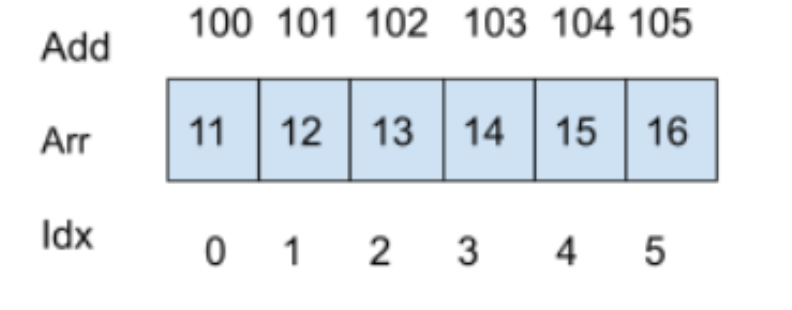
Time Complexity in arrays of size ‘N’:
- It takes O(1) time to access an element at a specific memory address because its relative address can be calculated in constant time in an array called "ARR," where the address of the first element is "A" and the size of each element is "S."
- In a similar vein, editing any array element takes O(1) time.
- In arrays, the only way to insert a new element at a specific index is to skip all of the elements before that index, which takes O(N) time.
- O(N) time is required for the deletion operation as well.
- Without a specific algorithm, the search operation in an array takes O(N) times because we have to iterate over and check each element.
Space Complexity in Arrays:
The space complexity of fetching, overwriting, inserting, and deleting is constant, or O(1), as we do not require additional space to perform any of the aforementioned operations. The auxiliary space consists solely of the space used to construct the array.
2. String
In computer science, a string is a sequence of characters that represent textual data, such as words, sentences, or entire documents. Strings are a fundamental data type in many programming languages, including C, Java, Python, and JavaScript.
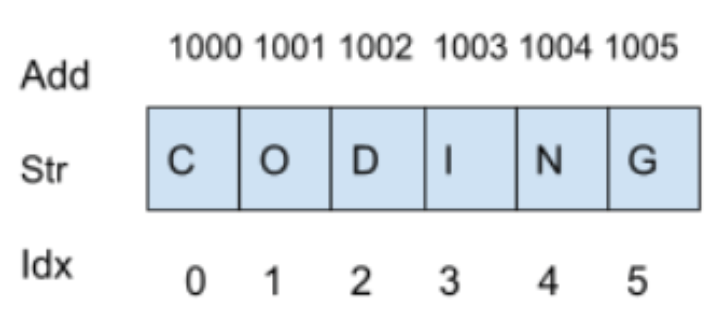
Time-complexity of Strings with N characters
- Because, like arrays, its relative index can also be calculated in constant time, reading or editing any character stored at a particular index takes O(1) time.
- Because we must skip all characters at previous indices, inserting and deleting any character at a particular index in strings takes O(N) time.
- Because we check for every character in the string, searching for any character in strings takes O(N) time.
Space Complexity in String:
The space complexity of reading, editing, inserting, and deleting is constant, or O(1), as we do not require additional space to perform any of the aforementioned operations. The auxiliary space is only the space used to make the string.
3. Queue
In computer science, a queue is a data structure that allows elements to be added at one end and removed from the other end in a first-in, first-out (FIFO) manner. This means that the first element added to the queue is the first one to be removed. Queues are commonly used in programming to manage resources that are shared by multiple processes or threads.
A queue is conceptually similar to a line of people waiting for service, where the first person in line is the first to be served. The two primary operations supported by a queue are:
- Enqueue: Adding an element to the back of the queue.
- Dequeue: Removing an element from the front of the queue.
In addition to these basic operations, queues may also support other functions such as peeking (viewing the first element without removing it), checking if the queue is empty, and determining the size of the queue.
Queues can be implemented using arrays or linked lists. In an array implementation, the front and back of the queue are tracked using indices, while in a linked list implementation, a pointer to the front and back nodes are maintained. Queues are used in a wide variety of applications, including operating systems, network protocols, and simulations.
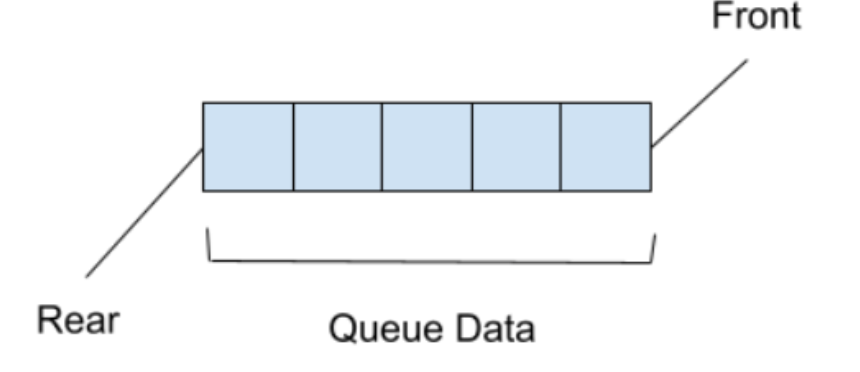
Time complexity of Queue with N elements:
- The time required to access or edit any element in a queue is O(N), and in order to reach any given element, all elements after it must be removed.
- Due to the fact that reaching any particular element necessitates popping the elements stored after it, the searching operation also takes O(N) total time.
- In a queue, insertion and deletion take the same amount of time, O(1). At any given time, only the front component can be removed, and only the back component can be inserted.
The queue's complexity in space:
Since no additional space is required for any operation, the space complexity of each operation in a queue is O(1).
4. Stack
In computer science, a stack is a data structure that allows elements to be added and removed in a last-in, first-out (LIFO) manner. This means that the last element added to the stack is the first one to be removed. Stacks are commonly used in programming for tasks that require the ability to undo or backtrack, such as in a web browser's back button or in a compiler's parsing of nested statements.
A stack is conceptually similar to a stack of plates, where the top plate is the last one added and the first one to be removed. The two primary operations supported by a stack are:
1. Push: Adding an element to the top of the stack.
2. Pop: Removing an element from the top of the stack.
In addition to these basic operations, stacks may also support other functions such as peeking (viewing the top element without removing it), checking if the stack is empty, and determining the size of the stack.
Stacks can be implemented using arrays or linked lists. In an array implementation, the top of the stack is tracked using an index, while in a linked list implementation, a pointer to the top node is maintained. Stacks are used in a wide variety of applications, including expression evaluation, function call management, and memory allocation.
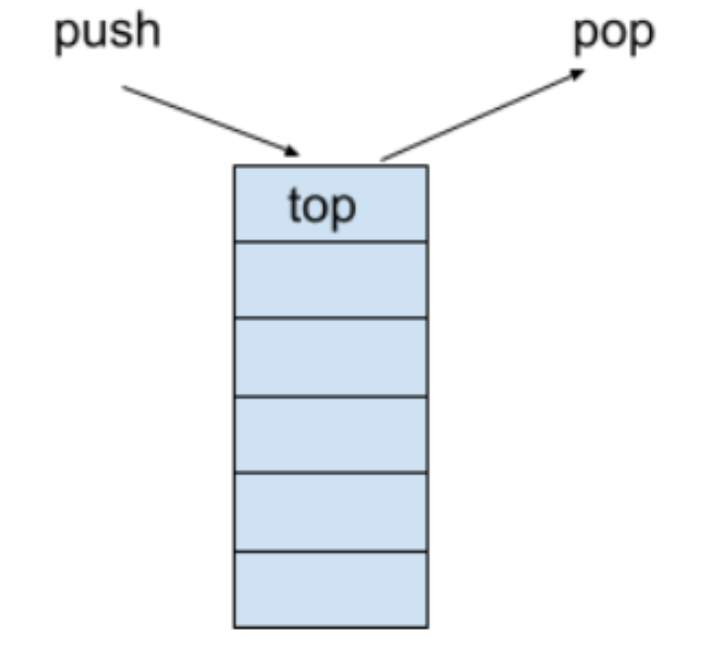
Time and complexity of a stack with N elements
- To access or edit any element in a stack, it takes O(N) times the number of elements to reach before it needs to be removed.
- Due to the fact that reaching any particular element necessitates popping the elements that were stored before it, the searching operation also takes O(N) total time.
- In a stack, operations like insertion and deletion take O(1) of time.
Space Complexity of Stack
Because no additional space is required for any operation, the space complexity of a stack for each operation is O(1).
5. Linked List
A linked list is a data structure in which data is stored between nodes. A pointer to the next node and a data field make up each node. Pointers are used to link the various elements in a linked list together. In contrast to arrays, elements in a Linked List are not stored in a single memory location but rather in multiple memory locations.
The complexity analysis that follows can be used to comprehend its effectiveness.

Time Complexity of a Linked List with N Elements
- The time complexity of inserting an element into the linked list is O(1) if done on the head and O(N) if done anywhere else because we have to go through the linked list to get there.
- The time complexity of deletion is O(1) if carried out on the head and O(N) if carried out at any other location due to the necessity of traversing the linked list to get there.
- The time complexity for searching and accessing any elements is O(N).
Space Complexity of a Linked List
Because no additional space is required for any operation, the space complexity of a linked list is O(1).
Summary
The time and space complexities of linear data structures are summarized in below table:
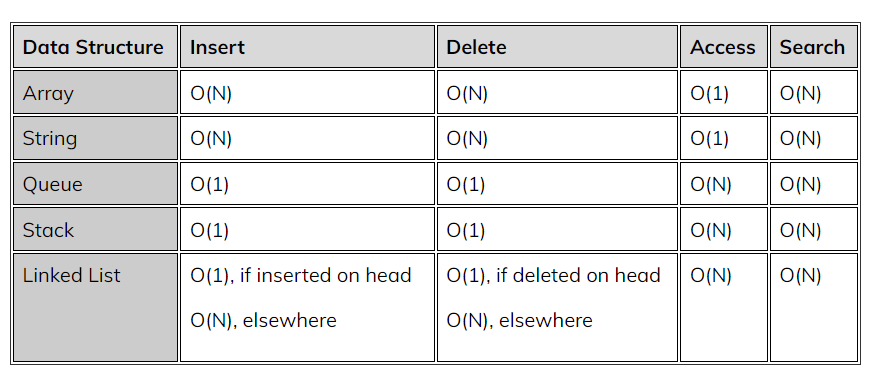
Where the respective data structure's size is N.